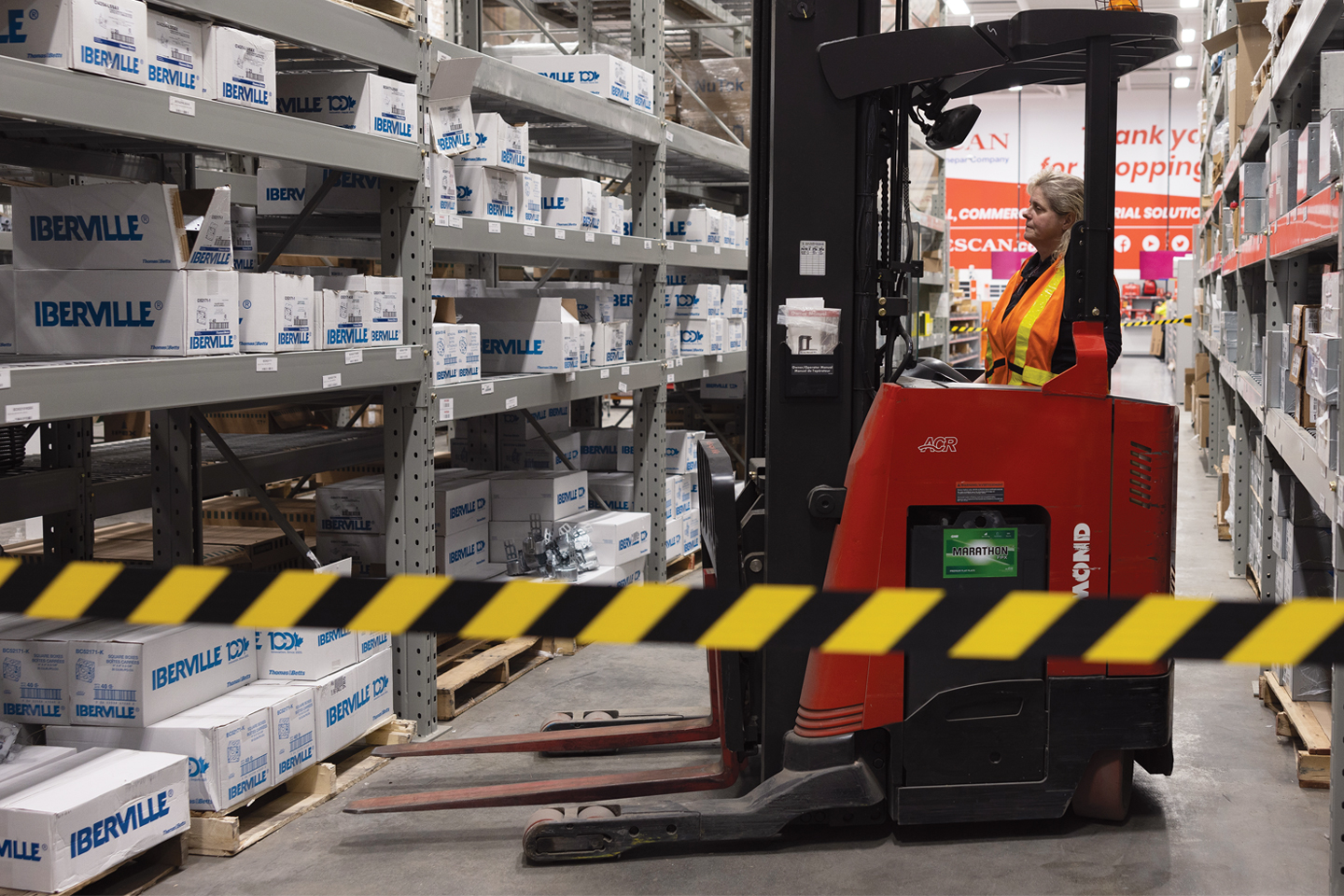Protecting workers from struck-bys in warehousing
Workers being struck by vehicles or mobile equipment such as forklifts, excavators, and trucks is one of the leading causes of serious and fatal injuries in the workplace.
By Marnie Douglas
One large warehousing employer has made it part of everyday operations to protect its workers from these incidents known as struck-bys.
Gescan is an electrical distributor with 15 locations across B.C., plus another 12 across Canada. The company recently approached WorkSafeBC to help them better identify any additional risks related to worker safety around mobile equipment.
“Our business model is similar to that of large home improvement stores, where customers come into the warehouse and pick the products themselves. There is tall bay storage racking and mobile equipment like forklifts and electric pallet jacks,” explains Edmund Soong, Gescan’s health safety and environment manager. “We recognize that when operating mobile equipment around employees and customers there are risks.”
Innovative ideas
Soong says that he challenged health and safety committees across all locations to come up with creative ideas to minimize interactions with mobile equipment. The next step was reaching out to WorkSafeBC for further advice.
A cross-departmental team from WorkSafeBC visited Gescan’s Coquitlam warehouse location in January to meet with staff and discuss workplace safety as it relates to preventing struck-bys. As part of the discussion, WorkSafeBC introduced the new fillable template that helps employers determine effective ways to eliminate or minimize interactions between workers and mobile equipment.
The template has an area to draw the worksite layout and identify where vehicles or mobile equipment operate near workers on foot. Employers can then work through risk factors and determine the most effective way to reduce the risk, as set out in the hierarchy of controls. At the top of the hierarchy, elimination (complete removal of the hazard) is the most effective category of controls. At the bottom of the hierarchy, using personal protective equipment is the least effective category of controls.
“Using the tool, we can identify high-traffic hotspots, isolate these areas, and divert foot traffic,” adds Soong. Jacqueline Morrison, OHS Consultation and Education Services manager at WorkSafeBC, is pleased that Gescan is enthusiastic about using the resource as part of its commitment to an even safer workplace.
“They use forklifts to lift stock up and down off the racking, so the risk is another worker on the floor or even a customer being struck by the forklift. They want to find ways to eliminate any interaction between workers on the floor and equipment,” she explains. One example is closing off the aisle when the forklift operator is moving stock up or down, which removes other foot traffic from being around the forklift.
Taking action in many ways
Morrison adds that it’s important for employers to have a robust near-miss reporting system as part of their overall health and safety program, since near-miss incidents don’t generally show up in first aid records. When aiming to prevent workplace incidents, Morrison reminds employers to also look at unusual, different, or unique conditions that can increase risk. Soong adds that Gescan does have an excellent system for reporting near misses.
This ongoing commitment to taking action on health and safety, protecting workers, and preventing injuries has a positive impact on health and safety culture, which in turn improves productivity and quality, Morrison adds.
WorkSafeBC ergonomist Heather Kahle is impressed with Gescan’s commitment to keeping workers safe — reaching out to WorkSafeBC for advice and having a keen interest to use the new assessment tools are two progressive steps. What is key is looking at the risk involved in struck-bys and, where possible, eliminating that risk.
“We cannot just rely on workers to pay attention all the time. People cannot consistently pay attention to everything going on around them all the time, especially when they’re focused on a task. It’s more important to eliminate the hazard — and that is the interaction between the mobile equipment and the worker,” Kahle says. By noting the movement patterns of mobile equipment and workers, as well as the layout of storage and loading areas, employers can find effective solutions.
Soong points out that branch supervisors and managers play a critical role in injury prevention, since they walk the floor and engage with workers most of the workday. If something changes in the workflow during the day — a shipment of products arrives unexpectedly and space needs to be found for storage, as an example — supervisors are aware. “They are the eyes and ears, and conversations are happening throughout the day between supervisors and workers.”
Managing worksite risks is an ongoing process, and one that Gescan is clearly committed to. “We want to continually challenge ourselves to look at new ideas around health and safety in our facilities,” says Soong.
For more information
Download your free copy of the fillable template and guide.
This information originally appeared in the Spring 2023 issue of WorkSafe Magazine. To read more or to subscribe, visit WorkSafe Magazine.

